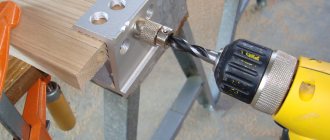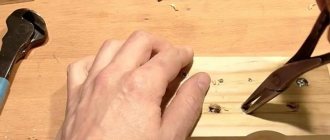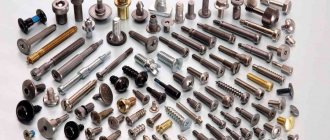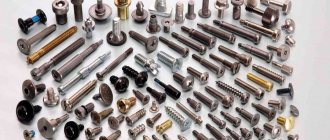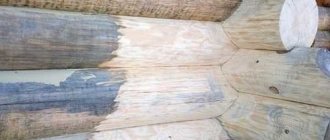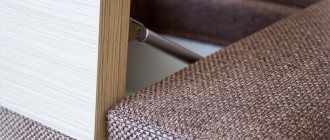Any metal screw, when screwed in, cuts a thread in the wood. In this case, the metal inevitably rubs against the wood fibers, and if you find that you have screwed in a screw slightly in the wrong place, you will have to carefully unscrew the screw and screw it again. In this case, the usual structure of the furniture may be disrupted. And you will be surprised to find that the screw has play in the thread. For lightly loaded and rarely used headset items, this play can be neglected. But any kitchen door will be in danger zone. Therefore, it is better to arm yourself with the three most effective methods for handling screws.
Features of fastening heavy structures to foam blocks
When fixing sliding wardrobes against the wall, the question arises of which screws to use to attach the chipboard to the foam block masonry. If you use the wrong hardware, the cabinet wall may be ripped out of the wall. To prevent this from happening, attach the chipboard to the foam block using special self-tapping screws:
- High-expansion metal dowel. Before screwing in the hardware, pre-drill the chipboard sheet in the desired location and prepare a hole in the wall. The anchoring depth and dowel shape depend on the planned load.
- Metal frame dowel - suitable for screwing heavy chipboard structures, including shelves and racks. A metal sleeve ensures fixation of the hardware inside the hole. An anchor for aerated concrete has structural differences from fasteners for ordinary concrete - keep this in mind when purchasing.
Also, the previously mentioned chemical anchors are used to fix chipboard structures on foam block walls.
How to repair a broken screw hole
As Alexander Kolomietz , when a low-quality screw is wrapped in poor chipboard, there is every chance that it will not stand there for a long time, especially in such loaded places as door hinges.
The most important thing in this matter is the correct drill. It is more reliable to use special wood drills, as they have sharper sharpening angles, which allows you to drill holes with better accuracy. And the more precise the hole, the more firmly the wooden insert will sit in it. However, if there is no special drill, then you can drill with a regular one. In this case, if possible, it is advisable to drill in several passes, gradually increasing the diameter of the drill.
Briefly about the main thing
Something as simple as screwing a self-tapping screw into the most ordinary materials can suddenly turn out to be difficult if you do not have experience and do not know how to do it correctly. To cope with this task, you need to choose the appropriate fasteners and tools, evaluate the features of the base on which you need to fasten. Most solid materials require pre-drilling or punching at mounting points. You can do without them when working with soft wood or thin sheet metal.
Fastening Features
What kind of self-tapping screws are needed for chipboard is a question, the answer to which can be found out from the consultants of the fastener store. Before turning to specialists, it would be useful to understand the topic yourself. The type of fastener depends on what is to be fastened and how, on the characteristics of the material and on the design of the future product. For example, you have to work with 16 mm thick chipboard sheets, and you don’t know which screws to use. Choose the most practical and reliable fasteners so that the connections are durable and can withstand operating loads.
When fastening chipboards, the sheets are connected in two ways - they make a through hole and screw fasteners into it, or make a hidden connection. Typically, the sheets being joined are at right angles to each other. It is also often necessary to nail a chipboard shelf to the wall. For such work, you need to choose dowels taking into account the characteristics of the material (brick, aerated concrete, foam blocks, wood) from which the wall is made.
Matches
Modern furniture is usually made from chipboard or MDF. When disassembling and reassembling, small pieces often fall out of the attachment point or small sections of material split. You can cope with the problem using an ordinary match. It is driven into the funnel (it is important that it is small in size), after which the self-tapping screw is tightened.
Using a match when tightening a self-tapping screw
After pressing against the wall, the match fills the crumbled area, and the reliability of the fastening increases. This method is suitable for products that are not subject to high loads and intensive use. On actively used connections, such fasteners will not last long.
What problems can happen with furniture hinges?
Modern designer furniture, kitchen units, cabinets, shelves, are complemented by closing doors made of different materials, which are connected using hinges. Because of them, various types of breakdowns occur and eventually the furniture hinge will need to be repaired.
Typical chipboard damage
To be precise, our furniture is made of chipboard - this is the official name for particle board, and chipboard means wood-laminated plastic. But it turned out that the second abbreviation took root, and it became the name of exactly the material that we are used to seeing in our homes.
The most common damage to chipboard panels can be considered the following:
- Scratches, cuts and cracks on the surface.
- Destruction of material in places where hinges and other metal parts are attached.
- Damage due to moisture.
Moisture getting inside the slab through damage to the coating will lead to irreversible changes in the material - swelling and loss of strength. Also, chipboard products cannot withstand dynamic loads; the hinge attachment points can break off along with part of the slab.
Chipboard repair in each of the listed cases will differ in complexity, tools and materials used. This will be discussed in more detail below.
Causes of problems
- The door fell off. So the loop couldn't stand it. Reason: weak screwing of self-tapping screws or screws.
- The hinges were torn out by the roots. The main reason is the incorrect calculation of the depth for the screws or the door is too heavy for this fastener. Frequent opening and closing of furniture doors.
- Deformation of fasteners. The protective decorative coating has peeled off. Violation of furniture manufacturing technology. A crack or dent has appeared under the varnish facing film. Improper drying of wood when making furniture. Wear of mobile joints. The furniture has become misaligned.
- Manufacturing defects. Due to incorrect manufacturing of connecting parts, the result is defective fasteners, which, when screwed in, lead to frequent breakdowns.
- Frequent disassembly. Unfortunately, with frequent disassembly and assembly of furniture, it leads to the fact that the previous holes in the seats can no longer hold the fastening loops.
- Loosening. Occurs from frequent opening and not careful closing of doors. Make adjustments using screws. Do not twist, check that the lid fits tightly to the surface and there should be no movement. Otherwise, deformation will occur.
- Incorrect fitting of furniture hinges leads to problems.
How to repair a broken furniture hinge?
When furniture breaks down, any modern interior loses its appearance and, at first glance, new furniture instantly turns into old trash. There is some confusion in this situation. An uprooted hinge immediately catches the eye of household members or guests who come to the apartment. You can repair a furniture hinge at home yourself.
We'll give you tips on repairing broken furniture hinges.
- You can raise the loop higher or lower it and screw it on.
- If there is nothing left to fasten to, then do the following: fill all the torn places with epoxy resin and put the fasteners in their original place. It has been proven that this method holds the loops for a long time. The resin must dry completely.
- Cut out the area of the torn loop and replace it with a new insert. Then adjust the color and attach a new loop.
- Attach a new block to the surface of the damaged door using self-tapping screws and screw in new hinges. If you don’t want to make other holes, then place the bars on glue and place them under a press. The press time is up to 10 hours, this is a kind of reinsurance against a new breakdown.
If there are only holes left on the surface of the furniture, then you can drive the wedges in and tighten them using special screws, but it is advisable to select them a little longer than the previous screws.
How to repair a broken furniture hinge
The furniture hinge on the façade can be torn out of its seat along with part of the chipboard. In this case, the ideal option would be to completely replace the door. However, it is not always possible to choose a material of the same shade as the main structure, and therefore it is worth trying to repair the canvas.
Broken hinges are a common problem with chipboard furniture.
There are two options:
- Move the hinges below or above the original installation location. This is an easier method, but it will require sealing the old holes. A plastic plug is suitable for this. If the hole is large, then it must be filled with a mixture of PVA and small sawdust. After final drying, the area is masked with wax and polished.
- Repair original seats.
You can repair the hinges using the two methods above.
A more complex option, but one that avoids new holes, which will extend the life of the facade. The works look like this:
- clear the landing site;
- pour a mixture of epoxy resin and sawdust into the recess;
- level the surface with a plastic or rubber spatula;
- wait for it to dry and, if necessary, add more mixture;
- After drying, sand the area;
- Mark the area and drill a groove for fastening to the required depth.
To extend the service life of hinges and facades, it is necessary to open the doors smoothly and not hang heavy objects on the handles, as this leads to distortion.
Loop position offset
This is the easiest way to fix a torn hinge - move it 1-2 cm up or down. However, we must remember that changing the position is necessary both on the door and on the cabinet itself. To make screwing in a new location easier, it is recommended to make small holes first, which will make it easier to secure the screws.
One way to repair doors is to move the mechanism to another location.
This method will cause a little more problems in the case of cup hinges, for which we will additionally have to cut holes to insert the hinge into them. The easiest way to do this is to use a carpenter's chisel.
Changing the position of the hinge is associated with leaving unsightly holes after the previous fixation of the entire mechanism. Fortunately, the holes are located inside the furniture and will remain invisible to outsiders.
The holes will not be visible to the naked eye.
Purchasing a new loop
Purchasing a new hinge is advisable if you do not want to waste your time and energy on repairs. In this case, loops of a different type and size are purchased, then they are installed in another location. The unnecessary hole is covered up, and the new mount is installed lower or higher than the old one.
In some cases, purchasing a new loop will help.
Seal holes with toothpicks or matches
This method is the simplest and to perform it we will need regular PVA glue, matches or wooden toothpicks. Next, put together the required number of toothpicks so that they fit into the hole as tightly as possible, then dip them in PVA glue and insert them into the hole.
Then take a hammer and easily hammer them into the hole until the end, leave until the glue has completely hardened. We cut off the remains sticking out of the hole with a stationery knife or a hacksaw, then clean it with sandpaper.
The aesthetic aspect of this method leaves much to be desired and may well be used in places where the hole will be hidden from view.
Repair using furniture confirmations
To secure the hinge, you can use special furniture fasteners - confirmats.
They are similar to self-tapping screws, have sharp threads, but are made of softer metal.
These fasteners have a larger diameter and sometimes it is enough to replace ordinary screws with them to return the door to its place.
To insert furniture fasteners, you need to drill out the damaged hole. Use a drill stop to prevent the door from going all the way through. It could even be a simple plastic tube from a felt-tip pen.
Then simply put the loop in place and secure it with a confirmat. But don't forget to add a self-tapping screw in the center of the hinge for security.
An alternative would be to use a metal liner. It is screwed into the hole and then a self-tapping screw is attached to it.
Mortise furniture nut and screw
If the hole did not fall out with chips when the self-tapping screw came off, you can drill it out and screw a furniture nut into it.
After this, the loop is installed on a screw instead of a self-tapping screw. This method is significantly stronger, since the mortise nuts have a larger grip area and therefore hold better.
6. Restore the hole with a wooden dowel
First of all, we measure the thickness of the chipboard. Next, take a wood drill and set either a limiter or a mark on it to make a hole of a certain depth. If your material thickness is, say, 9 mm, then you need to drill to a depth of no more than 7 mm.
The thickness of the drill is also selected individually, everything depends on the diameter of the screw being screwed in and the nature of the damage. I took a 5 mm drill. Carefully drill a blind hole.
There is no need to rush, because if you accidentally drill the front side, it will not be pleasant.
Pour wood glue around the edges. You can use the classic one - PVA or any other.
Naturally, the cap must be pre-fitted to this hole in diameter and length. Carefully drive it into the hole.
We are waiting for the glue to dry. Next, we drill a hole under the screw so that when screwing there is less internal stress, since the cap is made of a single piece of wood and with excessive pressure it will easily burst or crack.
That's all! The hole has been restored.
You can screw the screw into place.
The connection is very strong. Most likely even stronger than it was, since the insert adds additional density.
We repair all the necessary holes for the hinges.
Using this simple method, you can repair and restore a hole not only in chipboard, but also in other, absolutely any wood.
Wooden or metal die
A more labor-intensive method is to use a wooden or metal dowel, which we insert into the screw hole. However, the dowel needs to be a little wider, so we need to drill a hole the size of the dowel we want to put there.
During this operation, you must be very careful not to drill into the other side of the furniture and cause further damage.
You can use a dowel for repairs.
Then fill the hole with wood glue and insert the dowel into it. Then we leave everything for several hours. Once the glue has dried, cut the protruding part of the dowel down to the level of the plate. In addition, you can additionally sand this area with fine-grained sandpaper.
The last step is to screw the hinges back on. Using the above method ensures reliable fastening of the hinges for a long time.
After the procedure, the hinges are screwed on with a screwdriver.
Cold welding for chipboard and self-tapping screw
If, when the loop breaks, part of the chipboard is torn out, then the lost surface can be restored by cold welding.
You need to fill the hole with it, and while it is fresh, tighten it and remove the screw. After the weld has set, it is twisted back into a loop.
You need to fill the hole with it, and while it is fresh, tighten it and remove the screw. After the weld has set, it is twisted back into a loop.
Epoxy glue and pin
You can pour epoxy glue into the hole from the torn screw and screw the pin into it.
This can be done by cutting off the head of the bolt. To be able to rotate it with a screwdriver, you need to make a longitudinal cut at the end.
After the glue hardens, the loop is put on the pin and tightened with a nut.
After the glue hardens, the loop is put on the pin and tightened with a nut.
How to repair a hinge with epoxy resin
To repair larger damage, epoxy resin can be used. This is a plastic material that, after hardening, turns into a hard surface.
Epoxy resin consists of two components that must be mixed thoroughly before use.
You need to tightly fill the damaged hole with resin and level the surface flush with the main one.
While the resin has not hardened, you need to screw the confirmat into it and leave it until it hardens completely. The fastener can then easily be unscrewed from the wall and reinstalled along the thread through the loop.
Instead of a confirmat, you can use a regular bolt: cut off its head and make a slotted thread at the end.
Glue the bolt with the threads facing out using epoxy glue or drown it in resin, as in the previous version.
Then install the loop and secure it with a suitable nut.
If the inner surface of the wall is white, you can mask the repair area with a regular corrector, and for colored surfaces, select a suitable paint or cover the area with self-adhesive film.
You can also use filling the hole with cotton wool soaked in PVA glue. When the glue hardens, you can screw a self-tapping screw into this place.
Wire
Take a piece of wire and wrap it around a self-tapping screw. Then screw it into the hole in the wood in the usual way. Since the screw will have an increased size, it will fit tightly into the expanded funnel and will not fall out during operation of the product.
Other methods can be used to compensate for the gap. For example, craftsmen often use wooden plugs, from which they cut out wedge-shaped inserts and fix them in funnels.
It’s even easier to take a larger self-tapping screw than was used before - it’s perfect for creating a new fastener. Finding a way out is not difficult: you need to choose any suitable method, show imagination and a little skill.
12. Repairing chipboard furniture using epoxy plasticine
The repair material epoxy plasticine is sold in the form of a two-pack product (resin and hardener) or in the form of “sausages”, which must be thoroughly kneaded to mix the components.
To carry out repairs, do the following:
- Cut a piece of plasticine to the desired size.
- Wear gloves and thoroughly knead the epoxy until a homogeneous mass is obtained.
- If the chip is located at the location of the mounting hole, install a screw and fix it with epoxy.
- Form a neat patch, cut off its surface with a sharp knife, comparing it with the main plane.
- To obtain a more even patch, place a film on top and carefully press the damaged area with a block.
- Leave the repaired part until completely dry.
- The screw is removed from the epoxy mixture, obtaining a new hole with threads for fasteners.
- Sand the surface with fine-grain sandpaper and paint with oil paint of a suitable shade.
13. Restoring a broken place for a hinge
To work, you will need a lining and a bolt, which must be immediately screwed to the torn loop. The hole is clogged with oil to prevent epoxy resin from penetrating there in the future.
A small amount of epoxy resin and hardener are diluted on a film, a piece of masking tape, or in a disposable cup. Add a little filler (sawdust or construction putty) to make the mixture thick enough.
The resulting product is applied to the damaged area, then a loop is screwed on to hold it in place. Leave the part until completely dry. As the resin hardens, the lining will adhere exactly where needed.
Next, using clamps and a clerical blade, they make a kind of formwork for the edge: they fix the blade on top to limit the plane for pouring the mass. The inner surface of the chip from the outer edge is filled with a similar mixture (epoxy and putty) and allowed to dry.
At the next stage of work, you will need a small section of the sewer pipe, the diameter of which will exactly fit into the hole for the loop. Using masking tape, it is secured inside the round hole, and the remaining part of the damage is filled with epoxy mixture.
After drying, remove a piece of pipe and apply a finishing epoxy layer. As the initial setting progresses, carefully level it with the blade of a stationery knife.
New edges of a suitable color are glued to the ends of the furniture piece. To do this, use a hair dryer, an edge with an adhesive base and thick gloves for safety reasons.
The edge of the edge is heated with a hairdryer and pressed against the end of the part by hand. After cooling, the excess sections of the edge are cut to length and width using a special furniture veneer cutter or a regular stationery knife.
Next, the edge is sanded until the edge is perfectly even. At the end of the work, paint the repaired area with suitable paint and secure the loop.
Thanks to simple steps, you can give a second life to most products in the house and save on the purchase of new furniture.
How to repair a broken furniture hinge
It happens that a furniture hinge on the facade itself is pulled out of its seat along with pieces of laminated chipboard or MDF. The simplest option is to completely replace the module door. But the façade material may differ slightly in shade from the rest of the structure, and the cost of such repairs may be high.
You can repair the canvas and install the hinge yourself and at minimal cost. There are two options:
- Moving hinges above or below the original installation location.
- Repair of the hinge seat.
The first option is the simplest and fastest, but you will still have to seal the old holes. To disguise a broken seat, you can use a special plastic plug. Large holes are restored using PVA mixed with fine sawdust. After the mixture has dried, it is masked with wax pencils and polished.
Moving the loop to another location.
The second option is more complex, but, nevertheless, it will avoid making new holes and will extend the life of the facade for several more years. To restore the hinge seat you will need:
- epoxy resin;
- small sawdust;
- rubber or plastic spatula;
- electric drill;
- loop cutter.
A loop torn from the facade with “meat”.
First of all, you need to clear the seat of the torn loop, mix sawdust with epoxy resin and fill the recess, leveling the mixture with a spatula. Allow to dry and, if necessary, add more filler. After complete drying, sand the hinge installation area. Next, make markings and, using a cutter or electric drill, drill a groove of the required depth for the mount.
Prepare a mixture of sawdust and epoxy resin, and fill the seat of the furniture hinge bowl with epoxy resin.
The area for the hinge bowl is re-milled.
Reinstall the hinges.
Cold welding and screw
If the hole from the self-tapping screw is badly torn, it can be repaired by cold welding for chipboard. In this case, along with welding, you need to insert a bolt or screw with the head down. After the weld has solidified, a loop and nut are installed on top. If part of the weld is visible behind the loop, then it can be painted over.
Not very beautiful, but reliable: a simple repair option
If repairs are a matter of time for you, then you can go the simple route.
Drill through the wall with a thin drill where the hinge breaks.
From the front side, countersink the drilling area so that the bolt head is recessed.
Secure the loop with a bolt directly through the wall, recess the cap.
Hide the drilling site with a special furniture sticker - these are sold in hardware stores, and it’s easy to choose the right color.
Here is another visual material on repairs that may be useful to you:
Cotton wool and wood glue
When the torn self-tapping screw comes out neatly, without leaving a wide crater, the hole can be drilled out a little.
Then cotton wool mixed with wood glue or regular PVA is pressed into it.
When the mixture dries, you can screw the screw into it.
When the mixture dries, you can screw the screw into it.
How to learn to distinguish between self-tapping screws for different materials
A home craftsman most often has to work with metal, wood, and materials such as plywood, particle boards, and OSB. In each case, you need to select screws not only by size, but also by purpose. They differ in thread pitch.
- Hardware with a rare pitch are designed for wood.
- With frequent – for metal and other dense materials.
The so-called metal screws are actually universal - they can be used to screw everything except wooden parts. This is due to the structure of the material. Wood is fibrous and quite loose. Frequent threading will simply crush the fibers, so it is made sparse so that the wood fits between the protrusions of the metal spiral.
Correct use of fasteners
The choice of hardware when assembling furniture and other structures from particle boards is important. When using a confirmat (a screw with a countersunk head and a blunt end), after two or three screwings for assembly and disassembly during moving and transporting furniture, the self-tapping screw simply does not stay in the chipboard. When choosing hardware, you need to consider several factors:
- Required fastening strength.
- The degree of destruction of the chipboard when the dowel is repeatedly unscrewed and screwed in.
- Appearance of fasteners.
When it is necessary to attach chipboard to a base made of another material, for example, brick or foam blocks, the properties of the wall's masonry should also be taken into account. You cannot screw a chipboard shelf to a wall made of foam blocks using ordinary self-tapping screws - the fasteners will quickly fall out of the holes under the weight of the load.
Tools
The modern market for construction fasteners offers the buyer a wide selection of self-tapping screws - so necessary for any repair of products. However, reviews of these “little helpers” are not always flattering.
The thing is that home craftsmen often do not know how to screw in a self-tapping screw correctly and how to choose it correctly.
Table of contents
- Types of self-tapping screws
- Tools for tightening screws
- General technology for screwing in self-tapping screws
- How to screw self-tapping screws into different materials?
- How to properly tighten a screw that has been removed?
Types of self-tapping screws
There are two main types of self-tapping screws used for self-repair - for wood and universal. Their main difference is in the thread pitch - “screws” for wood are characterized by a large pitch (more rare application of thread turns).
Glue and sawdust
To restore a fallen piece of chipboard, you can use a mixture of glue and sawdust. You can make sawdust yourself. It is enough to take a little of the same chipboard or other wood-based material and chop it in any way.
You need to add a drop of construction adhesive (for example, PVA) to the mixture, carefully push it into the hole, and let it dry completely. Afterwards you can screw in the screw as usual. This method is ideal for lightweight doors, cabinets, and other products that will not open and close too often.
Some tips
It remains to focus on one more point: the color of the screws used. Some people who are far from construction believe that white or yellow hardware is decorative, they look better, and therefore are used for visible fastenings. In fact, their color is given by a special anti-corrosion coating, which prevents rusting of fasteners installed outdoors or in damp areas.
Black self-tapping screws do not have such a coating, so it is recommended to use them only for relatively light, unloaded structures in dry rooms.
Another frequently asked question: is it possible to screw metal screws into wood? The answer is no. Fine threads will not hold the fastener in loose material, and over time or under load it will fall out of the hole.
